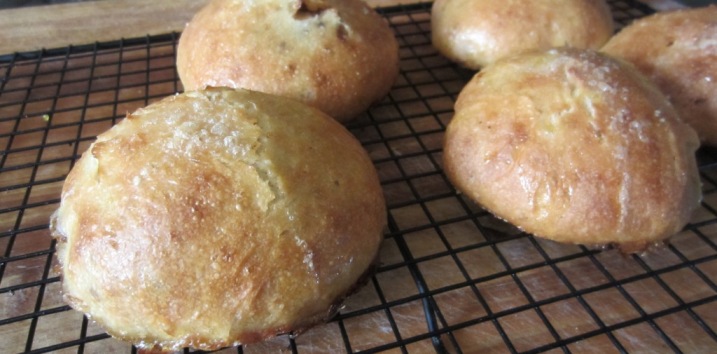Steamed or baked, fresh Chinese buns filled with hidden delights are a thing of beauty. Portable too. Whether you call them bao, humbao, baozi, or just “delicious”, they’re an easy staple you should add to your kitchen repertoire.
Filled with all manner of things from your leftovers stash or haphazard pantry, they are a yeast bun that have a very distinct texture. Delicate, supple, and springy all come to mind but there are as many different recipes for the dough as there are fillings for the inside. They populate the dim sum trolleys of Hong Kong equally as often as the street stalls of the night market in Vancouver,
A favourite maker at my former farmer’s market home was a “hom bow” kitchen no bigger than a generous closet that would crank out four or five flavours hourly. At two for five bucks with buns twice the size of my fist they made for a walking lunch many times in those days. Despite the butchered pinyin spelling, the quality was top notch as illustrated by their more than twenty years doing the exact same thing, day in and day out. Their barbecue pork, shredded chicken, and vegetable with mushroom versions topped my list of favourites but like all good farmer’s market stalls they varied the themes with the seasonal ingredients being hawked all around them. They chose to bake theirs and the tops always had a perfect little split with the tiniest sprinkling of caramelized sugar atop a golden egg wash.
On another bun adventure during a stopover in Shanghai one spring circa 2004, I sat down at a tiny cafe that made nothing but baozi. I had six hours to kill and was starving after a long flight. Theirs were much smaller and sold four on a plate in at least two dozen variations. Pork, chicken, sweet egg custard, cabbage & mushroom, sweet red bean… the list went on and on. I’m fairly certain I ate at least two dozen at one sitting before taking a stroll and coming back for round two. The staff were pleased that my appetite had no bounds. That’s always good guanxi in China because chefs there love an appreciative audience.
Making them at home is simple. Perfecting them at home, not so much. Variations in the dough recipe have haunted me for decades but I think I’ve finally cracked the code by using alkaline water, jian shui, to give them the spring and lift you get from the genuine article in Asia. I either bake or steam depending on my mood, sometimes even a bit of both, but I do typically use a pre-cooked filling considering the super-sized approach I take in the vein of my long-favourite market stall. You can adjust the size and cooking method to your own preference once you get the dough to your liking.
My advice if you start down this path is to make tiny batches of dough as unfilled buns, called mantou, for a few days until you get the texture you want. Then practice, practice, practice. My first attempts were abysmal but you’ll get better with each bun. You can then start filling them with wild abandon when your dough confidence has peaked.
edit: This week’s brief snowstorm came with the obligatory power outage that seems to be the utility company’s idea of joyous holiday season tradition by forcing everyone to roast their chestnuts over actual fires instead of that pesky modern electricity. That scuppered a few recipes in progress on the computer but I’ll recreate them shortly and update here asap. For my dough I use little more than flour, warm alkali water, and yeast but proportions are everything. Stay tuned for those details and a pile of filling ideas. Until then, here’s Jamie Oliver’s “cheat’s” method to show you the basic idea.

